All screenings are held at the Auditorium at Northeastern Illinois University (Building E, 3701 W. Bryn Mawr Ave., Chicago, IL 60625), unless otherwise noted.
General Admission: $5 • NEIU Students: $2, unless otherwise noted.
Programmed and Projected by Julian Antos, Becca Hall, Rebecca Lyon, Kyle Westphal, and Cameron Worden.
Wednesday, September 7 @ 7:30 PM / NEIU
SWEETIE
Directed by Jane Campion • 1989
The first feature film by director Jane 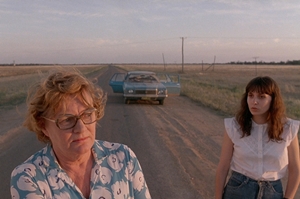 Campion, Sweetie is the story of a family “falling apart like a wet paper bag.” On the advice of a tea-leaf reading psychic, Kay (Karen Colston) steals her presumed soul mate from the arms of a coworker. Soon Kay and Louis (Tom Lycos) are living the suburban dream outside Sydney, Australia, working nameless jobs and watching their sex life disappear into the candy-colored linoleum. Enter Dawn, a.k.a. Sweetie (Geneviève Lemon), Kay’s feral, sexually charged sister, and let the hair pulling and destruction of all things beloved commence. Perhaps Campion’s funniest film (with the exception of the unfairly maligned Holy Smoke!), Sweetie is a fever dream occupied by needy, selfish children being literally (thanks to cinematographer Sally Bongers) and figuratively backed into corners. Released four years before Campion became the first (and only, as of 2016) female filmmaker to win the Palme d’Or at Cannes (for The Piano), it contains both the poetry and depravity that can be traced throughout her later work. Always ready and willing to treat seemingly mad and irrational characters with deadly sincerity, Campion makes no exception for neurotic, tree-fearing Kay, as we watch her demons made flesh in the film’s final scenes. (RL)
Campion, Sweetie is the story of a family “falling apart like a wet paper bag.” On the advice of a tea-leaf reading psychic, Kay (Karen Colston) steals her presumed soul mate from the arms of a coworker. Soon Kay and Louis (Tom Lycos) are living the suburban dream outside Sydney, Australia, working nameless jobs and watching their sex life disappear into the candy-colored linoleum. Enter Dawn, a.k.a. Sweetie (Geneviève Lemon), Kay’s feral, sexually charged sister, and let the hair pulling and destruction of all things beloved commence. Perhaps Campion’s funniest film (with the exception of the unfairly maligned Holy Smoke!), Sweetie is a fever dream occupied by needy, selfish children being literally (thanks to cinematographer Sally Bongers) and figuratively backed into corners. Released four years before Campion became the first (and only, as of 2016) female filmmaker to win the Palme d’Or at Cannes (for The Piano), it contains both the poetry and depravity that can be traced throughout her later work. Always ready and willing to treat seemingly mad and irrational characters with deadly sincerity, Campion makes no exception for neurotic, tree-fearing Kay, as we watch her demons made flesh in the film’s final scenes. (RL)
97 min • Arena Films • 35mm from NWCFS Collections, permission Janus
Film Stock: Eastman LPP (1989)
Short: “Hey Girls!” (Tom Palazzolo, 1990) – 16mm – 4 min
Wednesday, September 14 @ 7:30 PM / NEIU
THE BRIDGES AT TOKO-RI
Directed by Mark Robson • 1954
Existential dread induced by the possibility 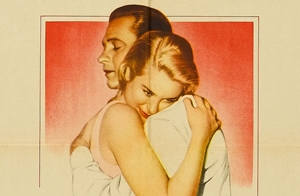 of dying a meaningless death for an arbitrary cause is not something one immediately associates with Cold War cinema of the 1950s, particularly not with fare as popular and successful in its time as The Bridges at Toko-Ri. All the same, it’s rare for a picture of its era to so bitterly and relentlessly puncture the myth that dying in war is a valorous and honorable act. William Holden anchors the film as Harry Brubaker, a naval aviator who is tasked with flying a strategically important mission to bomb the titular bridges. After his wife (Grace Kelly) and children visit him in Tokyo, Brubaker is thrown into a crisis, actively questioning his national and professional duties in the days leading up to the bombing. Filming in Yokosuka, Japan, and on the decks of various naval aircraft carriers, director Mark Robson evinces a strong eye for location shooting, proving adept at capturing the vibrant nightlife of postwar Japan as well as the labor required to launch and land airplanes at sea. While studded with bits of levity (supporting player Mickey Rooney’s diminutive, brawling helicopter pilot is a particularly fruitful source of comedy), The Bridges at Toko-Ri remains as intense and rattling an action picture as any to come out in its day, as well as a sober and unsparing look at the emotionally draining power of war. (CW)
of dying a meaningless death for an arbitrary cause is not something one immediately associates with Cold War cinema of the 1950s, particularly not with fare as popular and successful in its time as The Bridges at Toko-Ri. All the same, it’s rare for a picture of its era to so bitterly and relentlessly puncture the myth that dying in war is a valorous and honorable act. William Holden anchors the film as Harry Brubaker, a naval aviator who is tasked with flying a strategically important mission to bomb the titular bridges. After his wife (Grace Kelly) and children visit him in Tokyo, Brubaker is thrown into a crisis, actively questioning his national and professional duties in the days leading up to the bombing. Filming in Yokosuka, Japan, and on the decks of various naval aircraft carriers, director Mark Robson evinces a strong eye for location shooting, proving adept at capturing the vibrant nightlife of postwar Japan as well as the labor required to launch and land airplanes at sea. While studded with bits of levity (supporting player Mickey Rooney’s diminutive, brawling helicopter pilot is a particularly fruitful source of comedy), The Bridges at Toko-Ri remains as intense and rattling an action picture as any to come out in its day, as well as a sober and unsparing look at the emotionally draining power of war. (CW)
102 min • Paramount Pictures • 35mm from NWCFS Collections, permission Swank
Film Stock: Eastman (IB Tech) 1959
Short: “Schlitz Playhouse: Dual Control” (Paul Henreid, 1957) – 35mm – 30 min
Wednesday, September 21 @ 7:30 PM / NEIU
KING LEAR
Directed by Jean-Luc Godard • 1987
In retrospect, one wonders how an ’80s 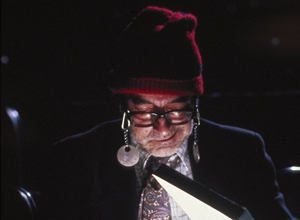 vintage, English-language Jean-Luc Godard Shakespeare interpolation could have turned out to be anything but a gloriously weird and obtuse misbegotten commercial prospect. Certainly the Cannon Group (storied producers of Bloodsport, Kickboxer, and Love Streams) thought they had a viable prestige product on their hands when they signed a much-ballyhooed napkin contract with the New Wave iconoclast, hiring Norman Mailer for a script that would go unused and later adding Burgess Meredith and Molly Ringwald as Lear and Cordelia. Instead, King Lear turned out to be almost certainly the most experimental major film adaptation of a Shakespeare work. Theater director Peter Sellars (who in his capacity as cowriter also assisted Godard in dismantling the play) plays William Shakespeare Jr. the Fifth who has been enlisted by the Queen of England and the Cannon Cultural Group to recover, through a sort of associative mysticism, the works of his great ancestor after they have been wiped from cultural memory following a nuclear disaster. His assignment brings him into constant orbit with the characters from Shakespeare’s play, as well as a strange group of researchers played by Julie Delpy, director Leos Carax, and Godard himself. A work of spectacular friction, King Lear is ultimately a Godard film through and through, averse to cogent narrative progression, richly beautiful, deeply intelligent, funny and ineffably moving. (CW)
vintage, English-language Jean-Luc Godard Shakespeare interpolation could have turned out to be anything but a gloriously weird and obtuse misbegotten commercial prospect. Certainly the Cannon Group (storied producers of Bloodsport, Kickboxer, and Love Streams) thought they had a viable prestige product on their hands when they signed a much-ballyhooed napkin contract with the New Wave iconoclast, hiring Norman Mailer for a script that would go unused and later adding Burgess Meredith and Molly Ringwald as Lear and Cordelia. Instead, King Lear turned out to be almost certainly the most experimental major film adaptation of a Shakespeare work. Theater director Peter Sellars (who in his capacity as cowriter also assisted Godard in dismantling the play) plays William Shakespeare Jr. the Fifth who has been enlisted by the Queen of England and the Cannon Cultural Group to recover, through a sort of associative mysticism, the works of his great ancestor after they have been wiped from cultural memory following a nuclear disaster. His assignment brings him into constant orbit with the characters from Shakespeare’s play, as well as a strange group of researchers played by Julie Delpy, director Leos Carax, and Godard himself. A work of spectacular friction, King Lear is ultimately a Godard film through and through, averse to cogent narrative progression, richly beautiful, deeply intelligent, funny and ineffably moving. (CW)
91 min • The Cannon Group • 35mm from Park Circus
Film Stock: Eastman LPP, manufactured in France (1987)
Short: “Bottom’s Dream” (John Canemaker, 1983) – 16mm – 9 min
Monday, September 26 @ 7:00 PM – Music Box Theatre – 3733 N. Southport Ave. – Admission: $7
THE DEVILS
Directed by Ken Russell • 1971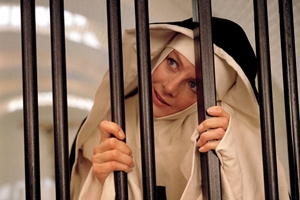
Co-Presented by Odd Obsession Movies
Based on real events and Aldous Huxley’s 1952 novel The Devils of Loudun, The Devils is still regarded as one of the most controversial films of all time, at this point probably more for its garishness than its actual content (disclaimer: The Devils is a beautiful film, no matter what your washed-out pan-and-scan VHS dupe might tell you). Directed by Roman Catholic Ken Russell with production design by Derek Jarman (Jubilee, The Tempest), the film stars Oliver Reed as a 17th-century French priest who is accused of being in league with the Devil and possessing an entire convent of nuns – the unforgettable Vanessa Redgrave is Mother Superior. Despite overwhelming criticism and tussles with the British Board of Film Censors, Russell was awarded Best Director by the National Board of Review in New York. One of the film’s early champions was fellow midwesterner Father Gene D. Phillips, who immediately added the film to his curriculum at Loyola University Chicago. From Richard Crouse’s book Raising Hell: “Russell said that because the film is taught by Jesuits as if it were a good Catholic film, chances are it is.” (JA)
108 min • Russo Productions • 35mm from Warner Brothers
Film Stock: Eastman LPP (1991)
Short: “The Red Spectre” (Segundo de Chomon, 1907) – 16mm – 7 min – Film print courtesy of The University of Chicago Film Studies Center
[ PRE-ORDER TICKETS THROUGH BROWN PAPER TICKETS ]
Wednesday, September 28 @ 7:30 PM / NEIU
THE SILENT ENEMY
Directed by H.P. Carver • 1930
Live organ accompaniment by Jay Warren
One of the last silent films released by a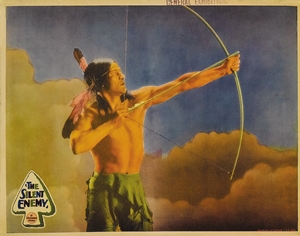 major studio—it contains one spoken monologue, which was sufficient for Paramount to promote it as the “all talking feature picture which required one year to film”—The Silent Enemy straddles the line between ethnographic documentary and sentimental fiction in the tradition of Nanook of the North. Inspired by the success of Cooper and Schoedsack’s Grass and Chang, safariing scions Douglas Burden and William Chanler endeavored to recreate and record the pre-Columbian lifestyle of the Ojibwa tribe of the Canadian Far North. Enlisting a professional Hollywood crew led by director H.P. Carver and cinematographer Marcel Le Picard, they spun a loose narrative allegedly drawn from 17th-century Jesuit histories of the region. The filmmakers’ devotion to authenticity went only so far; their cast was assembled from the “photogenic” ranks of First Nations people, with Ojibwa heritage preferred but not necessary. Their star, Chief Buffalo Child Long Lance, who claimed mixed heritage, had already been thoroughly assimilated into modern life, working as a journalist and serving with distinction in World War I before being adopted as an honorary Blackfoot; Chief Yellow Rose, who delivers the opening monologue, was a Sioux whom the filmmakers met at the American Museum of Natural History. In spite of its limitations, this empathetic portrayal of hunger and strife on the plains (the titular Silent Enemy) remains powerful and pictorially distinguished. Long circulated in a mutilated version prepared for the educational market, the original version of The Silent Enemy, rescued by David Shepard during his tenure at the American Film Institute, remains a capstone of silent cinema. (KW)
major studio—it contains one spoken monologue, which was sufficient for Paramount to promote it as the “all talking feature picture which required one year to film”—The Silent Enemy straddles the line between ethnographic documentary and sentimental fiction in the tradition of Nanook of the North. Inspired by the success of Cooper and Schoedsack’s Grass and Chang, safariing scions Douglas Burden and William Chanler endeavored to recreate and record the pre-Columbian lifestyle of the Ojibwa tribe of the Canadian Far North. Enlisting a professional Hollywood crew led by director H.P. Carver and cinematographer Marcel Le Picard, they spun a loose narrative allegedly drawn from 17th-century Jesuit histories of the region. The filmmakers’ devotion to authenticity went only so far; their cast was assembled from the “photogenic” ranks of First Nations people, with Ojibwa heritage preferred but not necessary. Their star, Chief Buffalo Child Long Lance, who claimed mixed heritage, had already been thoroughly assimilated into modern life, working as a journalist and serving with distinction in World War I before being adopted as an honorary Blackfoot; Chief Yellow Rose, who delivers the opening monologue, was a Sioux whom the filmmakers met at the American Museum of Natural History. In spite of its limitations, this empathetic portrayal of hunger and strife on the plains (the titular Silent Enemy) remains powerful and pictorially distinguished. Long circulated in a mutilated version prepared for the educational market, the original version of The Silent Enemy, rescued by David Shepard during his tenure at the American Film Institute, remains a capstone of silent cinema. (KW)
84 min • Burden-Chanler Productions • Tinted 35mm from Film Preservation Associates
Film Stock: Eastman LPP (1992)
Short: TBA
Wednesday, October 5 @ 7:30 PM / NEIU
OKAY, AMERICA!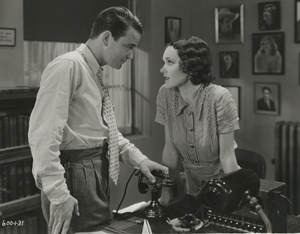
Directed by Tay Garnett • 1932
Every starlet, politician, and high society arriviste fears the acid tongue of Larry Wayne (Lew Ayres), prominent radioland gossipmonger and author of the New York Blade’s “Broadway Broadside” column. Aided by girl Friday Sheila Barton (Maureen O’Sullivan), Wayne embarks on the first act of bona fide journalism of his career: tracking down the kidnapped daughter of a prominent White House cabinet member. All paths lead to Edward Arnold, the rat-a-tat racketeer who eyes a presidential pardon. A corker of a pre-Code melodrama from underrated stylist Tay Garnett (Her Man, One Way Passage), Okay, America! borrows the tics and catchphrases of real-life radio spieler Walter Winchell to give voice to the anxieties of a nation on the precipice. Like its New Deal contemporaries This Day and Age and Gabriel Over the White House, Okay, America! is a work that blurs the line between extralegal excitement and hellzapoppin’ incitement. Does America need a fascist strongman to keep law ‘n’ order or would an entertainer-in-chief suffice? Remember to vote on November 8th! (KW)
78 min • Universal Pictures • 35mm from Universal
Film Stock: Kodak B+W (1999, Acetate)
Short: “The Editor’s Notebook” (Wilding Pictures Productions, 1950) – 35mm – 30 min
Tuesday, October 11 @ 7:30 PM / NEIU
THE HIRED HAND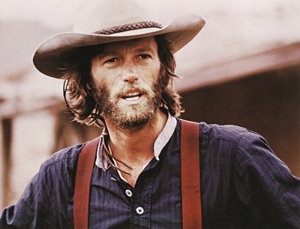
Directed by Peter Fonda • 1971
Peter Fonda’s first feature as a director is the gentlest western ever to break your heart, a sleepy-eyed answer to Easy Rider’s hippie narcissism and one of the best westerns of the seventies. Fonda plays a drifter who returns home to the wife he abandoned seven years ago (Verna Bloom), who will take him in only as a hired hand. When his partner (Warren Oates) is kidnapped by an old enemy, he leaves to rescue him. Shot in New Mexico by Vilmos Zsigmond just before McCabe and Mrs. Miller, The Hired Hand is glistening and grainy, with optical effects that give the feeling the film was woven together by hand during late nights at a wood burning fire. Too unassuming and elegiac to be a breakout hit, the film was met with either reverence or apathy on its original release. From the New York Times: “The Hired Hand knows that its Paradise is both tenable and actual, but it also knows that nobody can stay there for very long.” With music by regular Bob Dylan guitarist Bruce Langhorne. (JA)
90 min • Pando Company Inc./Universal Pictures • 35mm from Universal
Film Stock: Eastman 1972 (IB Technicolor)
Preceded by: ‘70s Westerns Trailer Reel
Saturday, October 15 @ 11:00 AM
HOME MOVIE DAY 2016
Presented by the Northwest Chicago Film Society and Chicago Film Archives.
Chicago History Museum, 1601 N. Clark Street • Free Admission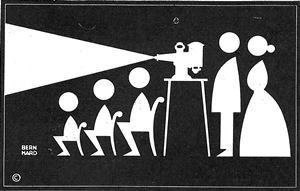
Go down to the basement and dig out your Super 8 memories of that interminable trip to Idaho or that embarrassing 16mm footage of your mother’s rockin’ bat mitzvah and bring them to the Chicago History Museum on Saturday, October 15 for this year’s edition of Home Movie Day. Jointly presented for the sixth year in a row by Chicago Film Archives and the Northwest Chicago Film Society, Home Movie Day offers Chicagoans the opportunity to gather together and share their celluloid histories. Home movies provide invaluable records of our families and our communities: they document vanished storefronts, questionable fashions, adorable pets, long-departed loved ones, and neighborhoods-in-transition. Many Chicagoans still possess these old reels, passed down from generation to generation, but lack the projection equipment to view them properly and safely. That’s where Home Movie Day comes in: you bring the films, and we inspect them, project them, and offer tips on storage, preservation, and video transfer–all free of charge. And best of all, you get to watch them with an enthusiastic audience, equally hungry for local history.
Monday, October 17 @ 7:00 PM – Music Box Theatre – 3733 N. Southport Ave. – Admission: $7
THE LUSTY MEN
Directed by Nicholas Ray • 1952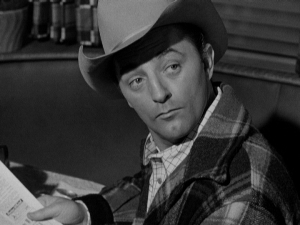
One of the superlative works turned out in the waning days of RKO as the studio atrophied under the erratic, inattentive leadership of Howard Hughes, The Lusty Men should never have come out so well. All its characters have seen better days, too: Robert Mitchum as the washed-up saddle tramp who knows when to walk; Arthur Kennedy as the ranch hand who still clings to a childhood of bronco-busting stardom; and Susan Hayward, who made the mistake of shackling herself to the immature Kennedy. Based on a Life magazine article and a mountain of research on the slang, rituals, and attitudes of modern-day cowpokes, the film had at least six writers; Mitchum and Ray purportedly threw out much of this work and simply improvised, writing the next day’s scenes when filming concluded each evening. Accordingly, The Lusty Men plays like a burnished myth, a folk mosaic that simply rose from the dirt. The best lines—“Never was a bull that couldn’t be rode, there was never a cowboy that couldn’t be throwed” —approach the archaic sublime. Restored by Warner Bros. in collaboration with The Film Foundation and The Nicholas Ray Foundation. Print courtesy of The Film Foundation Conservation Collection at the Academy Film Archive. (KW)
113 min • RKO Radio Pictures • 35mm from Academy Film Archive
Film Stock: Unmarked B&W Polyester Lab: Fotokem
Short: “Universal Color Parade: Junior Jamboree” (Thomas Mead, 1957) – 35mm – 9 min
[ PRE-ORDER TICKETS THROUGH BROWN PAPER TICKETS ]
Tuesday, October 18 @ 7:30 PM / NEIU
EQUINOX FLOWER
Directed by Yasujirō Ozu • 1958
In Japanese with English subtitles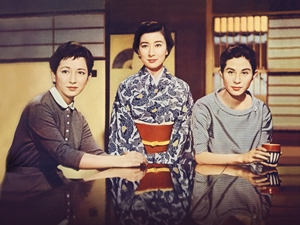
A youthful and invigorating film from an aging master, Equinox Flower is Ozu in full bloom. In the face of great cultural changes in postwar Japan, aging father Hirayama fancies himself something of a progressive in his views on marriage. When his own daughter Setsuko makes marriage plans for herself, however, Hirayama instinctively declines to give his consent-leading to a series of confrontations in which Hirayama’s hypocrisy is challenged. Infused with a wry, mildly petulant, but ultimately good-natured sense of humor, Equinox Flower, like so many of Ozu’s late films, portrays the older generation as befuddled and struggling with their children’s growing agency and disinterest in filial duty. Shooting in color for the first time (on achingly gorgeous Agfacolor stock), Equinox Flower found Ozu becoming an increasingly bold formalist, enlivening his compositions with the lush green of vegetation, as seen in exterior location footage, and a red teapot that seems to be perpetually in use yet always finds itself placed in an evocative position. (CW)
118 min • Shochiku • 35mm from Janus
Film Stock: Kodak 2383 (2002)
Short: “Trains” (Caleb Deschanel, 1976) – 35mm – 15 min
Tuesday, October 25 @ 7:30 PM / NEIU
THE VELVET VAMPIRE
Directed by Stephanie Rothman • 1971
Inspired by the overwhelming response to 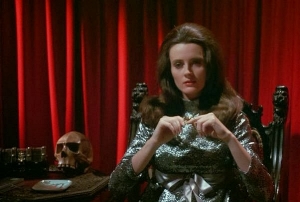 last season’s screening of The Student Nurses, we’re joyously digging deeper into the career of Stephanie Rothman, the only woman who ascended to the director’s chair at Roger Corman’s New World Pictures. Working on a miniscule budget with no stars and only an exploitation-ready title to goose the picture’s box office appeal, Rothman crafted a slow, kinky nightmare for the Southern California yuppie set. Wannabe hipsters Susan and Lee Ritter (Sherry DeBoer and Michael Blodgett) wander into the Stoker Gallery in LA and meet cute with the mysterious Diane LeFanu (Celeste Yarnall). She invites the couple to her home in the Mojave Desert for the weekend, curiously failing to warn them about the prospect of psychotronic trips and undead swinging. Beautifully lensed by Daniel LaCambre (one-time cinematographer for Eric Rohmer and Jean Eustache, embarking on the first of four films he would shoot for Rothman), The Velvet Vampire was nevertheless greeted as run-of-the-mill sex schlock, receiving a one-paragraph notice in the New York Times that concluded: “It is to be recommended only if you can see it at the New Amsterdam on 42d Street, where audiences loudly, freely, and obscenely associate with the action on the screen.” (KW)
last season’s screening of The Student Nurses, we’re joyously digging deeper into the career of Stephanie Rothman, the only woman who ascended to the director’s chair at Roger Corman’s New World Pictures. Working on a miniscule budget with no stars and only an exploitation-ready title to goose the picture’s box office appeal, Rothman crafted a slow, kinky nightmare for the Southern California yuppie set. Wannabe hipsters Susan and Lee Ritter (Sherry DeBoer and Michael Blodgett) wander into the Stoker Gallery in LA and meet cute with the mysterious Diane LeFanu (Celeste Yarnall). She invites the couple to her home in the Mojave Desert for the weekend, curiously failing to warn them about the prospect of psychotronic trips and undead swinging. Beautifully lensed by Daniel LaCambre (one-time cinematographer for Eric Rohmer and Jean Eustache, embarking on the first of four films he would shoot for Rothman), The Velvet Vampire was nevertheless greeted as run-of-the-mill sex schlock, receiving a one-paragraph notice in the New York Times that concluded: “It is to be recommended only if you can see it at the New Amsterdam on 42d Street, where audiences loudly, freely, and obscenely associate with the action on the screen.” (KW)
80 min • New World Pictures • 35mm from Private Collections, permission Criterion Pictures, USA
Film Stock: Eastman LPP (1983)
Short: “Halloween Safety (Second Edition)” (Coronet Films, 1986) – 16mm – 14 min
Tuesday, November 1 @ 7:30 PM / NEIU
A FACE IN THE CROWD
Directed by Elia Kazan • 1957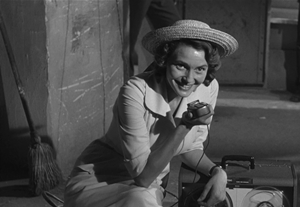
Andy Griffith was launched into stardom when he made his film debut as Larry “Lonesome” Rhodes, a honey- and vitriol-spewing Will Rogers-type good ol’ boy with a taste for power. With the help of radio producer Marcia Jeffries (Patricia Neal in one of her best roles), Rhodes makes the meteoric rise from sweaty jail cell philosopher to national television personality whispering into the ears of politicians. Eisenhower-era audiences were unimpressed with Elia Kazan and screenwriter Budd Schulberg’s potent satire about the dangers of television and its kingmaking powers, but it’s been pointed to over the years in times of dire need, as when New York Times film critic Nora Sayre called for a “widespread revival” of the film in the wake of Watergate. Director and critic François Truffaut never wavered in his affection for it: “There’s no denying that the film lacks consistency, but to hell with consistency! What’s important is not its structure but its unassailable spirit, its power, and what I dare call its necessity.” The distractingly good supporting cast includes Walter Matthau, Anthony Franciosa, and Lee Remick in her first film appearance. It’s time for a widespread revival of A Face in the Crowd! (RL)
126 min • Warner Bros. • 35mm from Warner Bros.
Film Stock: Eastman B+W (1979)
Preceded by: TV Commercials in 35mm
Wednesday, November 23 @ 7:30 PM / NEIU
TOPKAPI
Directed by Jules Dassin • 1964
Ever watch Jules Dassin’s Rififi and wish it 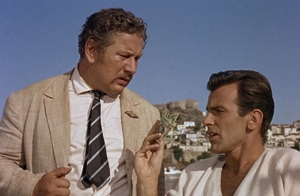 was a little less devastating? That the hardened criminals were a little less…hard? No? Ten years after Dassin made one of history’s greatest heist films, he does what on paper seems like a truly awful idea, a Technicolor spoof of the very genre he helped define. Shot on location in Turkey and Greece, the result is a surprisingly well crafted and joyous mix of tension and laughs. Elizabeth Lipp (Melina Mercouri) is our purring tour guide and mastermind behind the theft of a bejeweled dagger kept in Istanbul’s Topkapi Palace. She and her ex-lover (Maximilian Schell) gather together a motley crew of thieves for the job, including Robert Morley as a mechanics wiz, French actor and mime Gilles Ségal as “The Human Fly,” and last but not least, Peter Ustinov as a small-time con man hired as the driver. Ustinov’s sweating, bumbling hustler is widely considered to be the heart of the film (he won an Oscar for it that year), and he spoke highly of the role. “The character is so absurd. I love the idea of a man who aims low and misses.” Topkapi is famous for its 40-minute final heist scene, but don’t be late to this one because the psychedelic opening sequence is just as memorable. (RL)
was a little less devastating? That the hardened criminals were a little less…hard? No? Ten years after Dassin made one of history’s greatest heist films, he does what on paper seems like a truly awful idea, a Technicolor spoof of the very genre he helped define. Shot on location in Turkey and Greece, the result is a surprisingly well crafted and joyous mix of tension and laughs. Elizabeth Lipp (Melina Mercouri) is our purring tour guide and mastermind behind the theft of a bejeweled dagger kept in Istanbul’s Topkapi Palace. She and her ex-lover (Maximilian Schell) gather together a motley crew of thieves for the job, including Robert Morley as a mechanics wiz, French actor and mime Gilles Ségal as “The Human Fly,” and last but not least, Peter Ustinov as a small-time con man hired as the driver. Ustinov’s sweating, bumbling hustler is widely considered to be the heart of the film (he won an Oscar for it that year), and he spoke highly of the role. “The character is so absurd. I love the idea of a man who aims low and misses.” Topkapi is famous for its 40-minute final heist scene, but don’t be late to this one because the psychedelic opening sequence is just as memorable. (RL)
120 min • Filmways Pictures • 35mm from Park Circus
Film Stock: Eastman LPP (1991)
Short: “Sports in Action: Best in Show” (Richard Wink, 1964) – 35mm IB Technicolor – 10 min
Wednesday, November 30 @ 7:30 PM / NEIU
THE HEIRESS
Directed by William Wyler • 1949
Here for once is a Hollywood literary 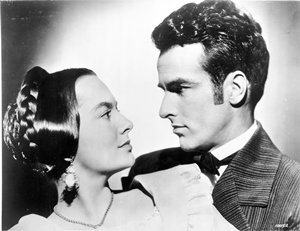 adaptation that lives up to its eight Academy Award nominations and its finely-honed sense of self-importance. (The original ad campaign simply tagged it as “A Truly Great Motion Picture,” confident that no further elaboration was necessary.) The project was instigated by Olivia DeHavilland, who caught Ruth and Augustus Goetz’s dramatization of Henry James’s novel Washington Square on Broadway and brought the property to the attention of William Wyler. Improbably, DeHavilland saw herself as the ideal actress to play sullen society spinster Catherine Sloper, daughter of a prominent New York doctor (Ralph Richardson, reprising his role from the London stage production) who shames and berates her constantly. Swept off her feet by the flirtatious entreaties of wastrel bachelor Morris Townsend (Montgomery Clift), Catherine must balance carnal desire and character judgment for the first time in her life. None of Wyler’s contemporaries match could him for stature or craftsmanship, and his films formed the backbone of André Bazin’s theories of mise en scène, yet his work is now screened all too infrequently. Assailed by Manny Farber and the auteurist critics who followed in his wake for the supposed crime of making arty films with social aspirations, Wyler and his work need no apology. A class act in every respect (including Aaron Copland’s score), The Heiress remains an expertly calibrated chamber drama that builds to an unforgettably cruel climax. (KW)
adaptation that lives up to its eight Academy Award nominations and its finely-honed sense of self-importance. (The original ad campaign simply tagged it as “A Truly Great Motion Picture,” confident that no further elaboration was necessary.) The project was instigated by Olivia DeHavilland, who caught Ruth and Augustus Goetz’s dramatization of Henry James’s novel Washington Square on Broadway and brought the property to the attention of William Wyler. Improbably, DeHavilland saw herself as the ideal actress to play sullen society spinster Catherine Sloper, daughter of a prominent New York doctor (Ralph Richardson, reprising his role from the London stage production) who shames and berates her constantly. Swept off her feet by the flirtatious entreaties of wastrel bachelor Morris Townsend (Montgomery Clift), Catherine must balance carnal desire and character judgment for the first time in her life. None of Wyler’s contemporaries match could him for stature or craftsmanship, and his films formed the backbone of André Bazin’s theories of mise en scène, yet his work is now screened all too infrequently. Assailed by Manny Farber and the auteurist critics who followed in his wake for the supposed crime of making arty films with social aspirations, Wyler and his work need no apology. A class act in every respect (including Aaron Copland’s score), The Heiress remains an expertly calibrated chamber drama that builds to an unforgettably cruel climax. (KW)
115 min • Paramount Pictures • 35mm from Universal
Film Stock: Kodak B+W (2001)
Short: Selected Cartoon
Tuesday, December 6 @ 7:30 PM / NEIU
COMFORT AND JOY
Directed by Bill Forsyth • 1984
Heartbroken after his girlfriend of four years leaves him just before Christmas, disc jockey Alan Bird (Bill Paterson) goes out for a drive and finds himself in the middle of a war between two rival ice cream truck gangs — If this sounds like a joke, it isn’t: throughout the 80s Glasgow was considered the murder capital of Western Europe, with rival gangs fighting for turf for their ice cream trucks full of drugs and stolen goods (and legit ice cream). The last of a quartet of films Bill Forsyth made in his native Scotland, Comfort and Joy was the highlight of a quietly awe-inspiring and productive period in Forsyth’s career, released a few years before NWCFS favorite Housekeeping. A foggy, melancholy comedy about “temporary insanity and loss of identity” (Forsyth’s words), Comfort and Joy captures the absurd melancholy of the yuletide season like lightning in a bottle. (JA)
106 min • Kings Road Entertainment • 35mm from Universal
Short: “Augusta Makes Herself Beautiful” (Csaba Varga, 1983) – 16mm – 5 min
